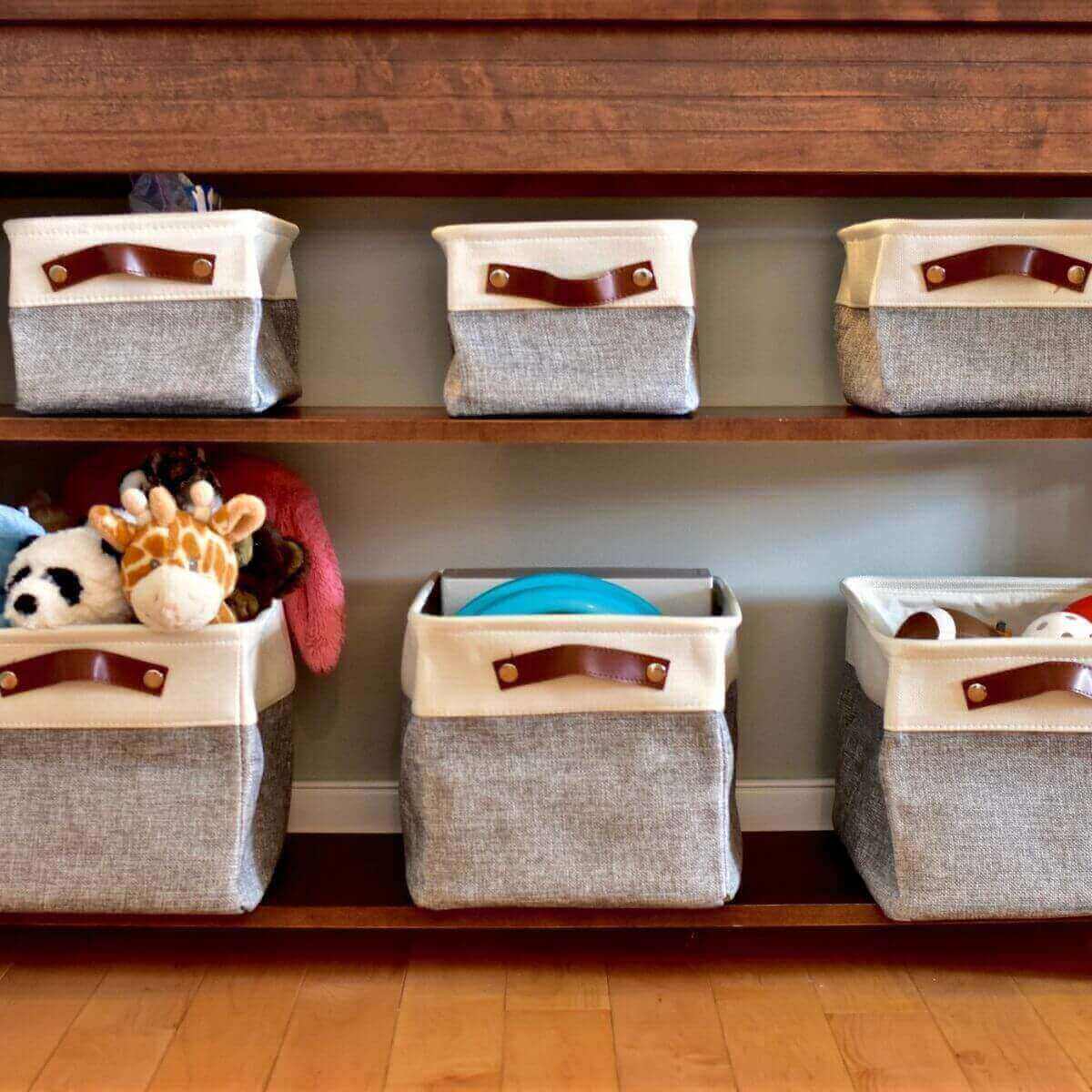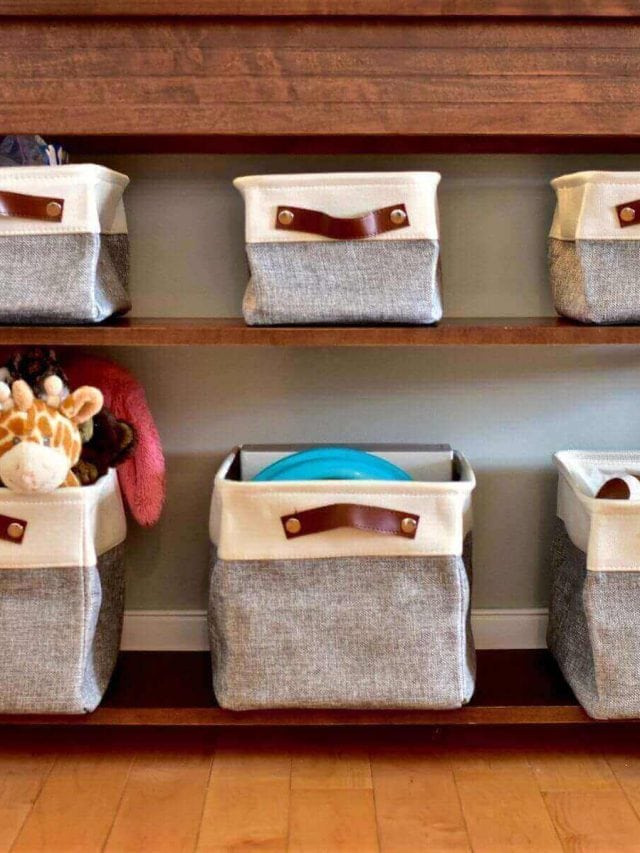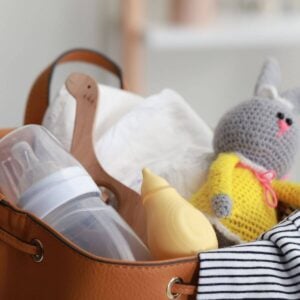Creating simple Montessori toy storage is an easy way to dip your toes into the Montessori method without investing a ton of time, money, and research.
At Undefining Motherhood, we love borrowing from the Montessori method to promote free play, independent learning, and emotional development in toddlers. And of course, it’s backed by loads of research.
In this article, we’ll reveal the basics of building a Montessori toy shelf as well as how to update your storage as your child grows. Bonus: you probably already have most of the materials you need!

This site contains affiliate links, meaning that we earn a small commission for purchases made through our site. We only recommend products we personally use, love, or have thoroughly vetted.
- What Is A Montessori Toy Shelf?
- What Should Be On Montessori Toy Shelves?
- What Are The Four Basic Principles Of Montessori Toy Storage?
- What Are The Best Kinds Of Shelves For Montessori Toy Storage?
- What Are Some Affordable Options For Montessori Toy Storage?
- Considerations For Montessori Toy Storage In Infancy And Toddlerhood (Ages 0-3 years)
- What Additional Materials Are Needed For Storing Infant And Toddler Toys?
- Considerations For Montessori Toy Storage In Preschool And Elementary School (Ages 3-6 years)
- Can I Really Have Montessori Toy Storage Without Diving Deep Into The Montessori Method?
What Is A Montessori Toy Shelf?
When we talk about Montessori toy storage, we often think about the pervasive Montessori shelf – a clean, almost bare toy shelf full of simple and beautiful toys.
A Montessori shelf is a central location for storing toys and activities. The materials are carefully selected by parents to meet a child (or children’s) unique developmental needs at a specific point in time.
Montessori influencers love to share their child’s shelves on social media, also called a “shelfie.”
You might be interested in creating that style in your own home, but maybe you don’t have any Montessori toys or know anything about Montessori principles. You are in the right place. Read on!
What Should Be On Montessori Toy Shelves?
Traditionally, Montessori toy shelves are full of Montessori toys and activities, but don’t worry. You can put any of your child’s favorite toys on a Montessori-style shelf.
If you’d like to know more about Montessori toys or the Montessori method in general, search “Montessori” on our website.
You’ll uncover articles chock-full of info including Montessori for Infants and Montessori Toys for 2 Year Old Toddlers.
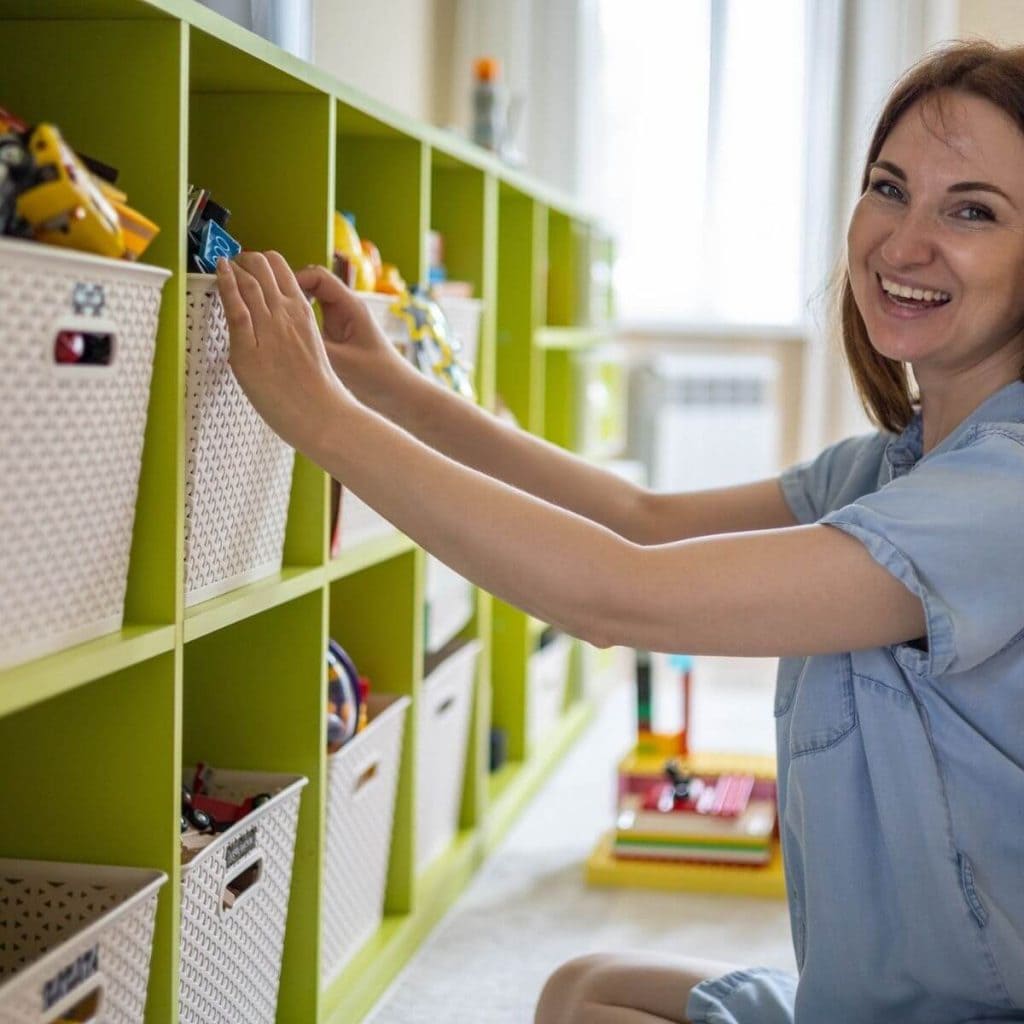
What Are The Four Basic Principles Of Montessori Toy Storage?
There are four main principles for creating and maintaining Montessori toy storage.
The main goal of this type of toy storage is independent, free play.
“The greatest sign of success for a teacher is to be able to say, “The children are now working as if I did not exist.” – Maria Montessori
Once you’ve mastered the principles, you can apply it to all of your child’s possessions – from clothes to kitchenware to art supplies.
1. Is it Visible?
Babies begin mapping their home environment from birth, so it’s important that children have an unobstructed view of where all their things are located.
In the same way, you may find recipes with pictures in a cookbook more enticing, your infant or toddler will be equally enticed by seeing what’s available to them.
As your children grow, certain materials can be stored away in bins or boxes, but your child may still use visual queues like picture labels to figure out where items are stored.
2. Is It Accessible?
An accessible toy is a toy that your child can independently remove from the shelf for play with little to no adult assistance.
For babies, this will involve having a shelf as low to the ground as possible so they can roll, crawl, or scoot right up to the toys.
As your child pulls to stand and gets taller, toys can be placed on multiple levels, generally no more than two levels of toys on any shelf for safety and simplicity.
Play is the part of a child’s life where they have the most control, and play builds confidence and capability.
We want to give our children every opportunity to play with and without parent participation, which is why accessibility is so important.
3. Is It Separate?
Toys should be stored in a way that a child can tell one activity or toy from another. When toys are all cluttered together, it’s hard to tell what items belong to each toy.
Even non-Montessori toys have certain purposes – some are puzzles to solve, some are balls to be thrown, and others are designed for open-ended play.
Children learn over time how to use each type of toy and what the rules are surrounding them. Keeping them separate with one toy per cubby or in low-sided trays reinforces this learning.
Don’t worry if your children combine different materials while playing. That’s perfectly ok as long as it’s safe and within the rules of your household.
4. Is It Curated?
A curated Montessori toy shelf is one that only includes toys appropriate for your child’s age and interests.
Montessori parents strive to include toys that are challenging but not impossible for a child to use. Consider what toys you have on hand that meet this criteria before buying anything new.
Curating toys also involves minimizing the number of toys available. For infants, a few toys on the shelf is perfect. For older toddlers, no more than ten. (This makes clean-up super fast!)
Rotate toys out of storage every couple of weeks to every month. Some beloved toys stay on the shelf year-round.
What Are The Best Kinds Of Shelves For Montessori Toy Storage?
The ideal Montessori shelf is low to the ground and includes one or two levels of shelving. It should be stable enough to prevent tipping or be wall-mounted.
Some unexpected Montessori storage ideas for non-Montessori homes include the lower shelves of a media console, a small bench, a shoe rack, or even a cabinet with doors removed.
Our family created a Montessori home in a 3,500 square foot house and a tiny apartment. You don’t need a lot of space to have Montessori toy storage.
Various styles of shelves are a popular item to list on secondary markets like Craigslist, Facebook Marketplace, or Offerup though you’ll want to get the brand and model information to ensure the finishes are non-toxic.
What Are Some Affordable Options For Montessori Toy Storage?
If you’re willing to spend money on a brand new shelf, the Ikea Kallax bookshelf with single or double levels is affordable and functional from birth to the teenage years.
This Birch storage cabinet from ECR4Kids and the toddler Montessori shelf from ECR$Kids are relatively affordable options to achieve a classic “Montessori” look.
Sellers tend to mark up anything that has the word “Montessori” associated with it, so simply searching for “low bookshelf” will help you find less pricey storage like this simple and attractive cube shelf.
Considerations For Montessori Toy Storage In Infancy And Toddlerhood (Ages 0-3 years)
In Montessori circles, children in this age group learn with an “unconscious absorbent mind.” They effortlessly soak up new information and skills like a tiny human sponge.
It’s a good thing, too! Most new parents don’t have extra energy for teaching.
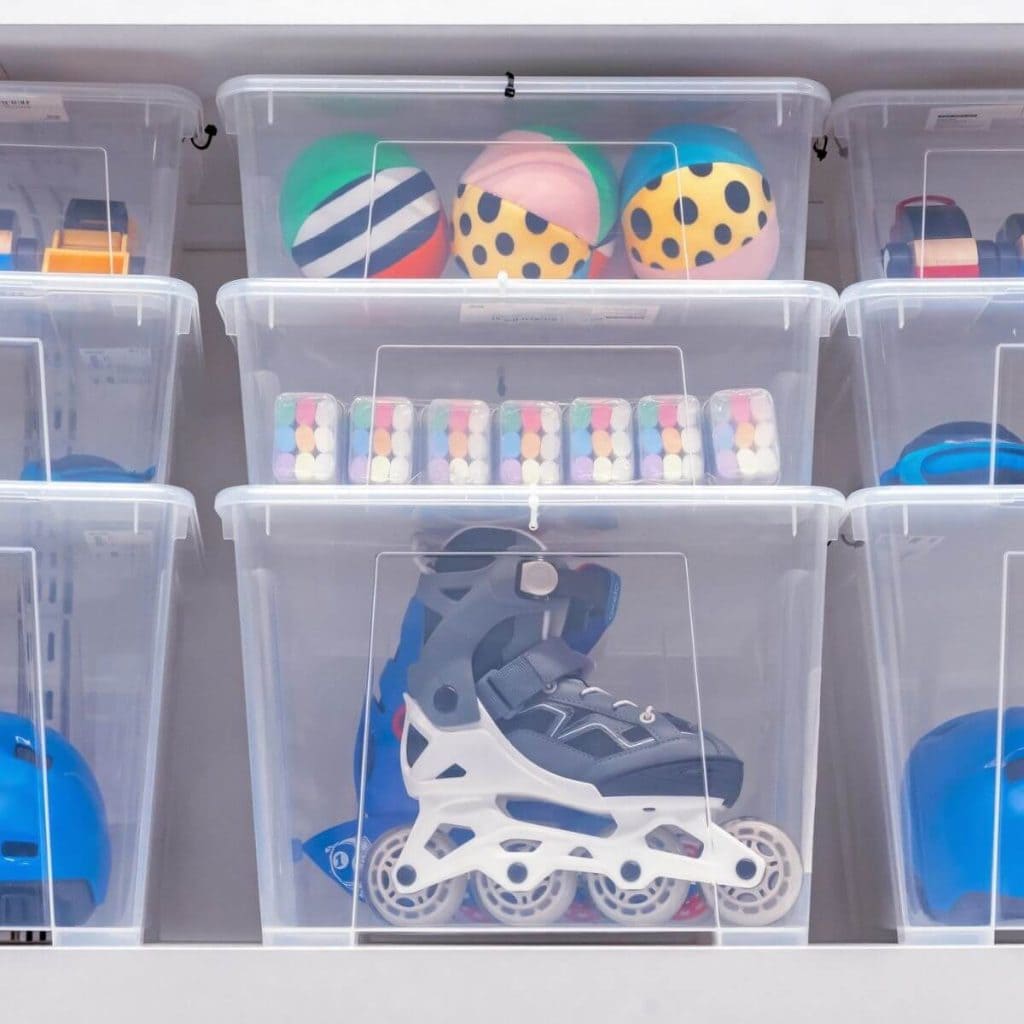
What Additional Materials Are Needed For Storing Infant And Toddler Toys?
A side effect of a child’s “unconscious absorbent” learning is that their attention is often wide and sweeping.
In neurology, this is sometimes called floodlight focus (as opposed to spotlight focus seen in the preschool years.)
To increase periods of focused playtime, we can use the following organizational tools as both physical and visual cues for our kids to engage with one toy at a time.
1. Small Trays
We use a combination of these low wooden trays and transparent plastic bins to organize our toys. Shop your own home first or visit the dollar store before making a big investment.
Trays with handles are nice if you’d like your child to bring their toys to a special table or play mat.
2. Small Bowls or Baskets
Small baskets or bowls made of wood, cloth, silicone, or plastic are wonderful for storing a toy that has multiple pieces.
In Montessori, toys are sometimes stored “unfinished” to entice a child to complete it. Place the toy shapes in a little bowl beside your shape sorter, for instance.
Since we’re not working with 100% Montessori materials, you can also try “strewing” where you set up toys in fun and silly ways.
Perhaps the teddy on your child’s shelf has snuck over to the book bin and is reading about a picnic? Or their plastic dinosaurs decided to start wearing little capes made of tissues?
Considerations For Montessori Toy Storage In Preschool And Elementary School (Ages 3-6 years)
This age is the beginning of active or intentional learning for a child. Until now, Montessori suggests a child is simply and unintentionally absorbing knowledge. At three, the child begins to consciously seek it.
A greater selection of toys and materials can be offered during this age as a child’s focus increases, and they can “tune out” other activities in favor of those that are engrossing to them.
The goal is to make these changes gradually and monitor your child for signs of overwhelm.
The Messes Are Getting Bigger! Is This Montessori Thing Still Working?
As your child grows, a simple Montessori shelf containing the toys you’ve selected becomes less and less attractive.
They know where all the cool big kid stuff is now, and they are fully capable of dragging it out of every closet, trunk, and cabinet. They have IDEAS that must be realized.
What Does Montessori Toy Storage Look Like For Older Children?
For older children, we still want to abide by all the principles of our original Montessori toy shelves – visible, accessible, separate, and curated – but apply it to distinct areas of play.
We are at the very beginning of redesigning our son’s toy storage, too. We’ve been really inspired by Hapa Family, a video series from a former teacher and Montessori parent.
Create one or more of these distinct play areas in your home using your original Montessori shelf and any other storage options as long as they abide by the four principles listed above:
- Art Supplies
- Books and Quiet Area
- Maker Space (It’s basically special storage and space for building materials like Magnatile or Lego.)
- Pretend Play (This goes well with the Maker Space.)
- Outdoor Play (For apartment dwellers, a go-bag of outdoor toys is great!)
- Family Board Games and Puzzle Shelf
Can I Really Have Montessori Toy Storage Without Diving Deep Into The Montessori Method?
It is absolutely possible to borrow from the Montessori method without massively changing your home and parenting style.
You don’t need special toys, special training, or expensive wooden furniture to enjoy the benefits of Montessori toy shelves.
Take what you’ve learned and create Montessori toy storage that is beautiful and unique to your family!
Did you know that I actually stored my infant’s Montessori toys on the hearth of our fireplace? What’s the weirdest place you’ve used to create Montessori toy storage?

